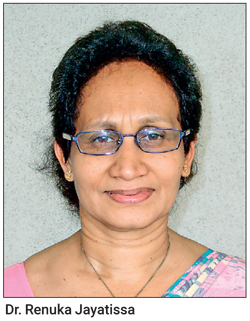Wednesday Apr 16, 2025
Wednesday Apr 16, 2025
Thursday, 4 May 2023 00:07 - - {{hitsCtrl.values.hits}}

By Randima Attygalle
 The findings of the latest National Nutritional and Micronutrient Survey (2022) by the Medical Research Institute (MRI) reveal that obesity here at home is no longer district-specific but cuts across all districts in the island. Among the highlights of the study which was carried out by the MRI from June to September in 2022, supported by UNICEF and WFP (UN World Food Program) are the trends in male-obesity in Sri Lanka. The island-wide representative sample of men between 18 and 60 years reveals that 25.6% are overweight, 6.4% are obese and about 11% of males are underweight. The findings also confirm that there is an increasing trend of obesity with increasing age. The study also shows that overweight is most prevalent in the Northern Province (13.4%).
The findings of the latest National Nutritional and Micronutrient Survey (2022) by the Medical Research Institute (MRI) reveal that obesity here at home is no longer district-specific but cuts across all districts in the island. Among the highlights of the study which was carried out by the MRI from June to September in 2022, supported by UNICEF and WFP (UN World Food Program) are the trends in male-obesity in Sri Lanka. The island-wide representative sample of men between 18 and 60 years reveals that 25.6% are overweight, 6.4% are obese and about 11% of males are underweight. The findings also confirm that there is an increasing trend of obesity with increasing age. The study also shows that overweight is most prevalent in the Northern Province (13.4%).
“As a middle-income country with limited resources, we have been prioritising our study groups and as a result, very often our focus has been pregnant women and children. However, for our 2022 National Nutritional and Micronutrient Survey, it was decided to get the baseline status of the nutritional levels among men including the nature of health interventions and health promotions required for them,” MRI’s Head of the Department of Nutrition and SAARC Food Association’s President, Dr. Renuka Jayatissa told the Daily FT. The survey is also a warning that the country’s disability rate and chronic disease burden is to accelerate, burdening the already exhausted health system in the country. According to the Central Bank statistics in 2022, the total health expenditure as a percentage of GDP was 1.34.
Underweight, as findings reveal is more prevalent in the estate sector. This has serious economic repercussions as one of the most productive segments of the Sri Lankan labour force is affected
Economic burden
The survey which takes an occupation-wise snapshot of obesity among men in the island also dispels the common myth that the farmer community with their intense physical activity are the healthiest cross section. “It is only 10 to 20% of Sri Lankans are physically active with sadly more than 50% of the population leading sedentary lifestyles. The farmer community falls within the active minority but unfortunately a good percentage of them are underweight and anaemic,” Dr. Jayatissa noted. According to the survey findings, about 8% of men over 40 are anaemic and 11% of men under 30 are underweight. Underweight, as findings reveal is more prevalent in the estate sector. This has serious economic repercussions as one of the most productive segments of the Sri Lankan labour force is affected. “Today we see many young men making a living as three-wheeler drivers who sit behind the wheel for prolonged hours with no physical activity. This is a serious situation,” says the nutritionist.
Health cost of NCDs
While many struggle to meet the ends with little heed to exercise and healthy diet, this comes at an enormous health cost. According to the WHO Non-communicable Diseases Country Profiles (2018), 83% of deaths in Sri Lanka are caused by NCDs; the leading cause being cardiovascular disease on which obesity has a direct bearing. According to the Annual Health Statistics 2019 published by the Ministry of Health, it is estimated that only 30~40% of recorded deaths occur in public hospitals here at home.
Worldwide obesity has nearly tripled since 1975 and more than 1 billion people are obese today. WHO estimates that by 2025 around 167 million people, including adults and children will become less healthy because they are overweight or obese. The estimated global economic impact of overweight and obesity by 2035 is $ 4.32 trillion. Obesity is one of the leading risk factors for Non-Communicable Diseases (NCDs). Among the top four NCDs worldwide are cardiovascular diseases, cancers, chronic respiratory diseases, and diabetes which are also the leading causes of morbidity and mortality worldwide.
The island-wide representative sample of men between 18 and 60 years reveals that 25.6% are overweight, 6.4% are obese and about 11% of males are underweight. The findings also confirm that there is an increasing trend of obesity with increasing age. The study also shows that overweight is most prevalent in the Northern Province (13.4%)
In Sri Lanka, as the ‘June 2022 Final Report of the Data Collection Survey on NCDs prevention/treatment in Sri Lanka’ initiated by JICA notes, ‘the mortality rate due to NCDs, mainly lifestyle-related diseases, has been higher than that of infectious diseases since the 1980s, and the difference has been expanding.’ The JICA report further notes that NCDs account for more than 75% of all deaths in Sri Lanka, with almost one in five early deaths. According to the UN Inter-Agency Task Force on NCDs, the prevalence of NCDs in Sri Lanka is a serious economic and public health problem, with smoking, unhealthy diets, harmful alcohol consumption, and physical inactivity contributing to the prevalence of NCDs. Over 25% of adult males in Sri Lanka, according to the report are smokers, and obesity is more prevalent among females, with approximately one in ten being obese. In addition, a large proportion of men and women have high blood pressure, with approximately one in four having it.
Diabetes threat
Sri Lanka as a global hotspot for diabetes today has the highest diabetes prevalence in South Asia. Obesity is one of the major risk factors for diabetes. Diabetes is a growing cause of global mortality and morbidity and a driver of healthcare costs. Global studies by the NCD Risk Factor Collaboration (NCD-RisC) and the International Diabetes Federation (IDF) indicate that diabetes in low and middle-income countries is increasing faster than in high-income countries with age-standardised prevalence in most developing regions higher than high-income countries. About 422 million people worldwide according to WHO, have diabetes, the majority living in low-and middle-income countries, and 1.5 million deaths are directly attributed to diabetes each year. Diabetes is a major cause of blindness, kidney failure, heart attacks, stroke and lower limb amputation.
Worldwide obesity has nearly tripled since 1975 and more than 1 billion people are obese today. WHO estimates that by 2025 around 167 million people, including adults and children will become less healthy because they are overweight or obese
The research paper titled, ‘Prevalence of diabetes and pre-diabetes in Sri Lanka: a new global hotspot- estimates from the Sri Lanka Health and Ageing Survey 2018/2019’ published in the British Medical Journal (BMJ) published in February this year notes that ‘the high prevalence in Sri Lanka may be due to it being the most affluent nation in South Asia with the highest rates of overweight and obesity.’ The study confirms that adult prevalence of diabetes was 23% in Sri Lanka in 2019, and pre-diabetes was 30%, significantly higher than previous estimates have suggested. It also notes that most of the increase in diabetes and pre-diabetes prevalence with BMI occurs in Sri Lankan adults of ‘normal weight’ as classified using WHO’s Asian BMI cut-offs.
The findings of the study suggest that the Asian BMI cut-offs are not adequate to capture the increased risk of diabetes in Sri Lankans and probably in other South Asians and underline the increased risk of diabetes in these populations at low body weights. Moreover, the findings ‘reinforce the need for increased research to understand the drivers of increased diabetes risk in South Asian populations and for increased efforts to tackle diabetes and underlying drivers such as weight gain in Sri Lanka.’
According to the UN Inter-Agency Task Force on NCDs, the prevalence of NCDs in Sri Lanka is a serious economic and public health problem, with smoking, unhealthy diets, harmful alcohol consumption, and physical inactivity contributing to the prevalence of NCDs
The National Health Policy 2016-2025 too states that efforts should be made to address NCDs such as diabetes, cardiovascular disease, and cancer, which account for the majority of causes of death, as well as to eliminate regional disparities in advanced medical services such as cardiac treatment facilities, palliative care, neurosurgery, and oral surgery, and to reduce premature mortality resulting from NCDs. In addition, the National Strategic Framework for Development of Health Services (2016 -2025) identifies health promotion and monitoring of NCDs as a strategic initiative.
Improving health literacy
With high literacy levels the country claims and increased connectivity, Dr. Jayatissa observes a mismatch in terms of Sri Lankans’ general health-literacy. “Individual health is not just the responsibility of the state or the Health Ministry’s. You are responsible for your health and watching your diet and starting physical activity after a heart attack will not work. It should be part of your lifestyle. Watching your weight, limiting the daily sugar intake, consuming more green vegetables and vitamin-C rich fruits and cutting down on junk food is not rocket science but common sense with increased exposure to health knowledge in this digital age,” reflects the nutritionist.
The research paper titled, ‘Prevalence of diabetes and pre-diabetes in Sri Lanka: a new global hotspot- estimates from the Sri Lanka Health and Ageing Survey 2018/2019’ published in the British Medical Journal (BMJ) published in February this year notes that ‘the high prevalence in Sri Lanka may be due to it being the most affluent nation in South Asia with the highest rates of overweight and obesity’
Emerging public health problems
Among the conclusions of the National Nutritional and Micronutrient Survey study are the identification of overweight and obesity as an emerging public health problem among all the age groups including pregnant women during the first trimester, micronutrient deficiencies as public health problems among children, non-pregnant, men and pregnant women.
The study also shows the relatively high prevalence of vitamin D deficiency in all studied age groups indicating the need for attention to improving vitamin D intake among all groups. It also observes zinc deficiency and vitamin B12 deficiencies as emerging micronutrient problems. High level of food insecurity at household level is also a serious concern according to the survey.
Discover Kapruka, the leading online shopping platform in Sri Lanka, where you can conveniently send Gifts and Flowers to your loved ones for any event including Valentine ’s Day. Explore a wide range of popular Shopping Categories on Kapruka, including Toys, Groceries, Electronics, Birthday Cakes, Fruits, Chocolates, Flower Bouquets, Clothing, Watches, Lingerie, Gift Sets and Jewellery. Also if you’re interested in selling with Kapruka, Partner Central by Kapruka is the best solution to start with. Moreover, through Kapruka Global Shop, you can also enjoy the convenience of purchasing products from renowned platforms like Amazon and eBay and have them delivered to Sri Lanka.
Discover Kapruka, the leading online shopping platform in Sri Lanka, where you can conveniently send Gifts and Flowers to your loved ones for any event including Valentine ’s Day. Explore a wide range of popular Shopping Categories on Kapruka, including Toys, Groceries, Electronics, Birthday Cakes, Fruits, Chocolates, Flower Bouquets, Clothing, Watches, Lingerie, Gift Sets and Jewellery. Also if you’re interested in selling with Kapruka, Partner Central by Kapruka is the best solution to start with. Moreover, through Kapruka Global Shop, you can also enjoy the convenience of purchasing products from renowned platforms like Amazon and eBay and have them delivered to Sri Lanka.